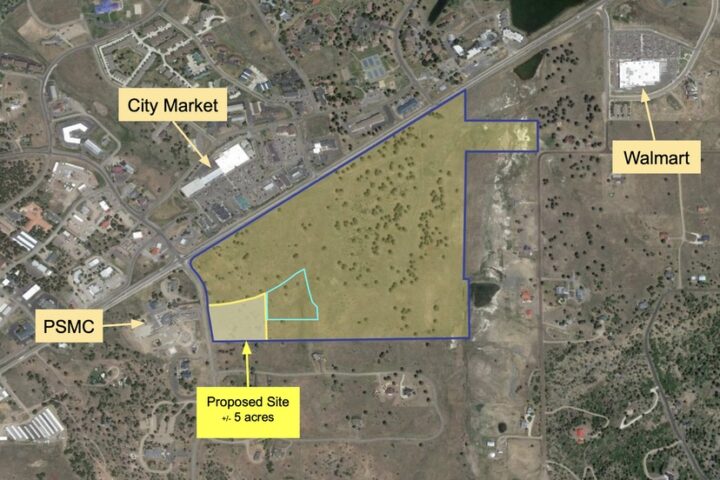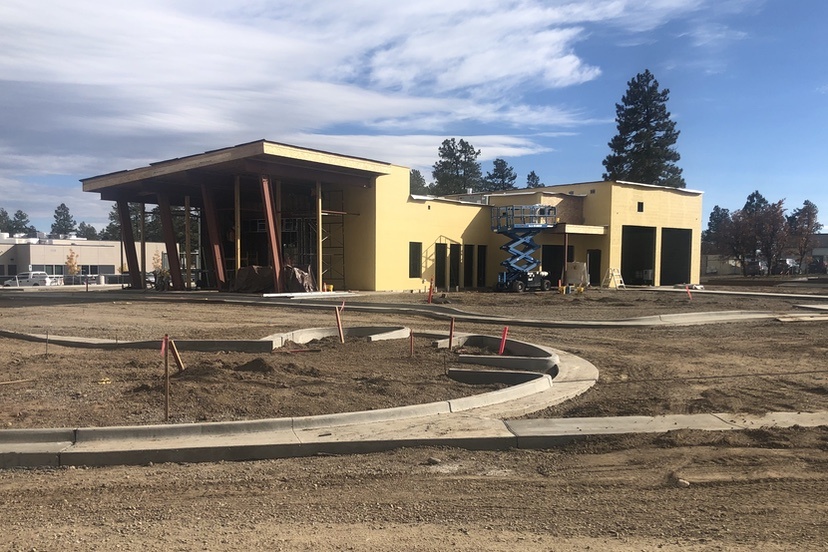Photo: Archuleta County Transportation Facility, under construction, October 2024.
On Friday, I changed the banner photo on the Daily Post home page — another great photo by my friend Jeff Laydon at Pagosa Photography — showing a view of the San Juan River in winter, looking east. It’s an historical photo, taken prior to the Springs Resort expansion projects and the construction of the Geothermal Greenhouse Partnership growing domes.
In a sense, any kind of documentation is outdated as soon as it gets recorded. Time moves on.
Pagosa Springs has obviously changed somewhat since I moved here in 1993, and the changes continue. I took a photo, the other day, of the new Archuleta County Transportation Facility in Harman Park. My granddaughter Simone was with me when I stopped to take the photo, and she asked why this building was being built. I explained that the County wanted a dedicated bus facility, partly in hopes of someday offering regular bus service to Durango.
Simone wondered why anyone would want to ride a bus to Durango. I love it when kids ask thoughtful questions.
But some things haven’t changed very much. I mentioned in Part One of this editorial series that the Archuleta County government has approved about 300 subdivisions over the past 50 years, most of which are relatively small, but a few stretch across several square miles. The Pagosa Lakes subdivisions, for example, cover 21 square miles. The Aspen Springs subdivisions occupy about 9 square miles.
But if memory serves, only a couple of moderate-sized subdivisions have been created since I moved here in 1993. One of them is the Aspen Village subdivision, home of Walmart, Centerpoint Church, Pagosa Peak Open School, and a few smaller businesses and residential clusters. From what I can tell from the County Assessor’s map, more than half the subdivision remains vacant, almost 20 years later.
A local realtor told me, last week, that in many situations, a large subdivision will never build out completely. In fact, it’s typical for about 20% of the parcels in a subdivision to remain vacant, indefinitely, for various reasons. Or so he told me.
The first subdivision created in Archuleta County — known as the Town of Pagosa Springs — has existed since 1883 and is still not fully built out. And perhaps, never will be.
In Part One I also noted that our primary water utility, Pagosa Area Water and Sanitation District (PAWSD), charges an ‘availability fee’ to property owners who have not yet built on their parcels but who are also within 100 feet of a water pipeline. This fee helps maintain 300 miles of water pipelines, so that whenever the owner is ready to build, they can connect to a well-maintained system.
According to current data, PAWSD serves about, 6,484 water customers and collects ‘availability fees’ from another 2,170 property owners.
As of 2024, it would appear that about 75% of the parcels in the PAWSD district have been built out, and 25% remain vacant.
But if our subdivisions are typical, maybe 20% of the parcels will never be built out. Without the development of some exciting new subdivisions within the PAWSD district, our community may be very close to “done”, in terms of residential growth .
The development of a new subdivision in 2024 has become incredibly expensive, compared to the cost 50 years ago. Simply looking the cost of materials, fuel, engineering, and labor, and not even considering the expenses caused by stricter government regulations… the prospect is daunting.
A few months ago, the Dragoo family approached the Archuleta Board of County Commissioners about locating a new (and expensive) administration building on 5 acres, within a proposed 100-acre development at the corner of Highway 160 and South Pagosa Boulevard. The Dragoos described the proposed County administration building as the project’s ‘anchor tenant’. I thought the Dragoos sounded a little bit desperate, and a bit too interested in having the Colorado taxpayers pay for part of their proposed subdivision project.

Normally, an ‘anchor tenant’ for a mixed use subdivision would be a major retailer… not a modest government office building.
From Wikipedia:
Some examples of anchor stores in the United States are: Macy’s, Sears, JCPenney, Nordstrom, Neiman Marcus, Saks Fifth Avenue, Dillard’s, Kohl’s, Walmart, and Target.
Since that list was posted, Sears has closed its stores, and JCPenny and Nieman Marcus have filed for bankruptcy. Macy’s, the country’s largest department store chain, has announced plans to close 150 stores over the next three years. The Nordstrom family has offered to buy their struggling company from the shareholders. Kohl’s saw its earnings drop by more than 40% year-over-year in 2023.
It’s entirely possible that in 2025 and going forward, future subdivisions — if any are developed — will be funded by the taxpayers. Possibly even by local taxpayers.
If that’s the case, I foresee very few new subdivisions being developed in Archuleta County.
Since 2016, almost all of the major construction projects in Archuleta County — the new County jail, the new County Courthouse, the new County bus facility, the new PAWSD water treatment plant on Snowball Road, the new workforce housing projects on Hot Springs Boulevard and on Alpha Drive — have been funded mainly through taxes, customer fees, or tax credits. The ambitious expansion of the Pagosa Springs Medical Center in 2017 has been funded partly by property taxes and wealthy donors, but mainly by local people with illnesses and medical insurance.
My thoughts about growth, in this editorial series, were prompted by the fact that, within the next couple of years, PAWSD may triple its access to raw water. I mentioned in Part One that — when this happens — PAWSD will theoretically be prepared to serve a Pagosa community three times its current size.
Theoretically.
I think these indicators suggest that Pagosa cannot, and will not, triple in size in the foreseeable future.
And not just for geographical and financial reasons.

